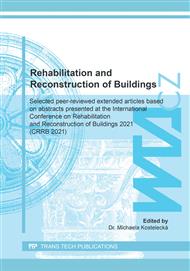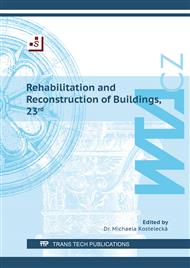[1]
WU, Jianmin, Jianguo LIU a Fei YANG. Three-phase composite conductive concrete for pavement deicing. ELSEVIER. Construction and Building Materials [online]. 2015, 30 January 2015, 2015(75), 129-135 [cit. 2020-10-25]. ISSN 0950-0618.
DOI: 10.1016/j.conbuildmat.2014.11.004
Google Scholar
[2]
TERASHITA, Keijiro, Tetsuya TANAKA, Kiyohiko NISHIMURA a Kei MIYANAMI. Continuous kneading for electrically conductive composite materials and evaluation of filler dispersion state. Bulletin of the University of Osaka Prefecture, Series A Engineering and Natural Sciences. 1993, 42(1), 51-67.
Google Scholar
[3]
XIE, Ping, Ping GU a J. J. BEAUDOIN. Electrical percolation phenomena in cement composites containing conductive fibres. Journal of Materials Science. 1996, 31(15), 4093-4097. ISSN 1573-4803.
DOI: 10.1007/bf00352673
Google Scholar
[4]
El-Dieb, A. S., El-Ghareeb, M. A., Abdel-Rahman, M. A. H., Nasr, E. S. A. Multifunctional electrically conductive concrete using different fillers. Journal of Building Engineering 2018, Volume 15(September 2017), 61–69. https://doi.org/10.1016/j.jobe.2017.10.012.
DOI: 10.1016/j.jobe.2017.10.012
Google Scholar
[5]
MONTEIRO, A.O., P.B. CACHIM a P.M.F.J. COSTA. Electrical Properties of Cement-based Composites Containing Carbon Black Particles. Materials Today: Proceedings. 2015, 2(1), 193-199. ISSN 2214-7853.
DOI: 10.1016/j.matpr.2015.04.021
Google Scholar
[6]
YEHIA, S. a J. HOST. Conductive concrete for cathodic protection of bridge decks. ACI Materials Journal. 2010, 107(6), 577-585.
DOI: 10.14359/51664044
Google Scholar
[7]
MAMUNYA, Y., L. MATZUI, L. VOVCHENKO, O. MARUZHENKO, V. OLIYNYK, S. PUSZ, B. KUMANEK a U. SZELUGA. Influence of conductive nano- and microfiller distribution on electrical conductivity and EMI shielding properties of polymer/carbon composites. Composites Science and Technology. 2019, 170, 51-59.
DOI: 10.1016/j.compscitech.2018.11.037
Google Scholar
[8]
J. Xu, W. Yao, Current distribution in reinforced concrete cathodic protection system with conductive mortar overlay anode, Constr. Build. Mater. 23 (2009) 2220–2226.
DOI: 10.1016/j.conbuildmat.2008.12.002
Google Scholar
[9]
El-Dieb, A. S., El-Ghareeb, M. A., Abdel-Rahman, M. A. H., Nasr, E. S. A. Multifunctional electrically conductive concrete using different fillers. Journal of Building Engineering 2018, Volume 15(September 2017), 61–69. https://doi.org/10.1016/j.jobe.2017.10.012.
DOI: 10.1016/j.jobe.2017.10.012
Google Scholar
[10]
Y. He, L. Lu, S. Jin, S. Hu, Conductive aggregate prepared using graphite and clay and its use in conductive mortar, Constr. Build. Mater. 53 (2014) 131–137.
DOI: 10.1016/j.conbuildmat.2013.11.085
Google Scholar
[11]
Liu, K., Cheng, X., Li, J., Gao, X., Cao, Y., Guo, X., … Zhang, C. Effects of microstructure and pore water on electrical conductivity of cement slurry during early hydration. Composites Part B: Engineering 2019, Volume 177(September),107435. https://doi.org/10.1016/j.compositesb.2019.107435.
DOI: 10.1016/j.compositesb.2019.107435
Google Scholar
[12]
ČSN EN 197-1: Cement - Part 1: Composition, specifications, and conformity criteria for cements for general use.
Google Scholar
[13]
ČSN EN 196-1 Methods testing cement- Part 1: Determination of strength.
Google Scholar
[14]
ISO 9277:1995(E) Determination of the specific surface area of solids by gas adsorption using the BET methods.
Google Scholar



